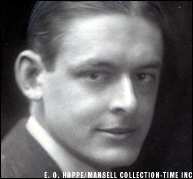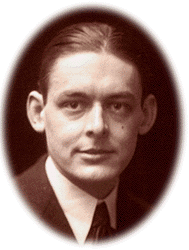

Do I dare
Disturb the Universe?
In a minute there is time
For decisions and revisions which a minute will reverse.
--"The Love Song of J. Alfred Prufrock" (1910)

Born in St. Louis, Missouri, in
1888, Thomas Stearns Eliot came from a prominent midwestern family responsible
for starting up Washnigton University in St. Louis , among other things.
At the age of 18, Eliot began attending Harvard University, where he studied
eastern philosophy and metaphysical poetry, among other things. Upon
completion of his PhD dissertation on the philosophy of F.H. Bradley, he
received a fellowship to come to Sonnborne and England to study at Oxford
under Bertrand Russell, and while he was there, he became great friends
with the intellectual.
Now that the lilacs are in bloom
She has a bowl of lilacs in her room
And twists one in her fingers while she talks.
'Ah, my friend, you do not know, you do not know
What life is, you who hold it in your hands';
(Slowly twisting the lilac stalks)
'You let it flow from you, you let it flow,
And youth is cruel, and has no remorse
And smiles at situations which it cannot see.'
I smile, of course
And go on drinking tea.--"Portrait of a Lady" (1911)

What Eliot introduced the world to was an incredible assimilation of culture past and present, east and west, living and dead, all juxtaposed on top of one another in an epic melodrama of decay and fruitlessness, given a final twist at the end when the narrator turns his back on the Waste Land and begins to "set [his] lands in order.". This unique world view (plus the incredible breadth of material it is drawn from) baffled many scholars and it was only after the publication of The Waste Land: A Facsimile and Transcript of the Original Drafts in 1971, six years after the poet's death, that made Eliot's intentions more clear. One inspiration Eliot may have had in mind was the untimely death of his friend Verdenal; though when one scholar, John Peter, attempted to publish an article to this effect in 1953, Eliot threatened to sue him and his publication running it, if he went through with it. It was only published (with revisions) after his death, in 1969. Eliot also began to publish critical essays at this time. his first book, The Sacred Wood, is considered an importnat treatise of literary theory and criticism. Taken as a whole, his essays are what made him (in the eyes of scholars) one of the greatest critics of this century.After the torchlight red on sweaty faces
After the frosty silence in the gardens
After the agony in stony places
The shouting and the crying
Prison and palace and reveberation
Of thunder of spring over distant mountains
He who was living is now dead
We who were living are now dying
With a little patience--The Waste Land, "What the Thunder Said" (1922)
In 1925, he wrote, "The Hollow Men," an austere poem known for its incredible economy of words, about the emptiness that naturally followed the impotent turmoil of The Waste Land. By this point, Vivienne had overdosed on her pills several times, and Eliot consulted with the Bishop of Oxford and another attempt at finding faith. He made the decision (based in part on Eliot's almost obsessive desire to be more British than the native British) in 1927 to become a subject of the British Empire and was confirmed into the Church of England. He was now, by his own admission in his essay For Lancelot Andrewes (1928), "classicist in literature, royalist in politics, and Anglo-catholic in religion."The eyes are not here
There are no eyes here
In this valley of dying stars
In this hollow valley
This broken jaw of our lost kingdomsIn this last of meeting places
We grope together
To avoid speech
Gathered on the beach of this tumid riverSightless, unless
The eyes reappear
As the perpetual star
Multifoliate rose
Of death's twilight kingdom
The hope only
Of empty men.--"The Hollow Men" (1925)
After his entry into the Anglican church, his subject matter and tone evolved from one of utter finality and doom to one of penitence and missed rapture. His poem "Ash Wednesday," published in 1930, shows an Eliot that has attempted to achieve a spiritual form of enlightenment, but is thwarted, "At the first turning of the third stair," on a metaphorical ascension nearer to God. He comes away from the poem (and in his life) losing the battle, but not the entire war ("Suffer me not to be separated/And let my cry come unto Thee"). He also penned five poems which he called the "Ariel" poems: each explored a different aspect of religious doubt, discovery, or revelation. Poems such as "Journey of the Magi" and "Marina" draw on both secular and sectarian imagery and incident to explore this complex of faith.Because I know that time is always time
And place is always and only place
And what is actual is actual for only one time
And only for one place
I rejoice that things are as they are and
I renounce the blessed face
And renounce the voice
Because I cannot hope to turn again
Consequently I rejoice, having to construct something
Upon which to rejoice--"Ash Wednesday" (1930)
In 1935, Eliot began to turn his attention toward the English stage, and a revitalization of verse drama such as there had been in the seventeenth centuries with the Elizabethan and Jacobean dramatists, among them Shakespeare, Jonson, and Webster. Designed as a choir mass for a religious festival in 1935, Murder in the Cathedral showcased Eliot's triumphal entry into theater, effectively dramatizing the martyrdom of Saint Thomas a'Becket at the hands of the English crown. In other plays, such as Murder and The Family Reunion (1939), Eliot uses the Greek choral ode tradition to provide continuity between his subdued, modern characters, and the honored tradition of Greek tragic drama. His other plays included The Cocktail Party, The Elder Statesman, and The Confidential Clerk, all of which made the more popular crossover than his earlier plays. Things were not their happiest on the home front, though. In 1934, Eliot and Maurice Haigh-Wood (her brother) were forced to commit Vivienne to a mental institution because she was getting out of control, terrorizing Eliot's friends and brandishing knives against others. They had applied for a legal separation a year or two beforehand, but they were forced to make the final split at that time. In addition, Eliot wrote "Burnt Norton," in 1935--the first of four poems that dealt with the nature of history, the necessity of a timeless moment, and the role time plays on humanity and faith, later published as Four Quartets in 1943, after Eliot finished "East Coker," "The Dry Salvages," and "Little Gidding," the other three poems in the cycle.I have spoken to you today, dear children of God, of the martyrs of the past, asking you to remember especially our martyr of Canterbury, the blessed Archbishop Elphege; because it is fitting, on Christ's birth day, to remember what is that peace which He brought; and because, dear children, I do not think I shall ever preach to you again; and because it is possible that in a short time you may have yet another martyr, and that one perhaps not the last. I would have you keep in your hearts these words that I say, and think of them at another time. In the name of the Father, and of the Son, and of the Holy Ghost. Amen.--Murder in the Cathedral (1935)
Four Quartets were structually set up in five 'movements,' much like a symphony piece or a sonata. Eliot's use of candences and complex religious and allegorical allusions effectively completed the cycle from The Waste Land's nihilistic apocalypse, beyond the penitence of "Ash Wednesday" and the "Ariel" poems, to finally an understanding and comfort with faith. His Dante voyage ended, Four Quartets provides a fitting finality to Eliot's poetic portion of his career (with the exception of a few occasional verses at the behests of friends). He wrote treatises of social criticism at this time as well, the best of them culminating in Christianity and Culture, a series of essays surrounding the necessity of the Christian religion in modern western society.At the still point of the turning world, neither flesh nor fleshless;
Neither from nor towards; at the still point, there the dance is.--"Burnt Norton," from Four Quartets (1935)
Eliot was also responsible for starting the poetic careers of several other British poets a generation after him. Poets such as W.H. Auden, Ted Hughes, and Stephen Spender were given their first big opportunities at publishing through the publishing firm of Faber and Faber, where Eliot was an editor from 1925 on until his death. In 1948, he received the Nobel Prize in Literature for his contribution to English poetry, and in the same year, King George VI bestowed on him the Order of Merit, a rarely given-out honor for his contribution to English letters. In 1947, Vivienne Eliot died in Northumberland Hospital in England, a santiarium where she was incarcerated through her brother Maurice and Eliot's power of attorney over the Haigh-Wood estate (since she was the eldest child, she would inherit it). Eliot did not see her the last twelve years of her life, isolating himself from the pain of their troubled marriage, though at the end, menopause had brought a quiet end to the hormonal embalances that raged through her the first forty years of her life. She would take her silence to the grave, wondering when Eliot was going to see her again, knowing that she still loved him. Now, I am no expert on what was in Eliot's mind; the mind can only wonder. However, one possibility may be that he was unable to re-open those wounds in his past. Another possibility is that he could not face her, not so much out of "the rending pain of reenactment" that would play in his mind, but out of a fear to face her, once he had made his final decision about committal (even though it is possible to consider that he felt that it was a mistake, and he failed in his duty to take care of her by committing her).We are born with the dead:
See, they return, and bring us with them.
The moment of the rose and the moment of the yew-tree
Are of equal duration. A people without history
Is not redeemed from time, for history is a pattern
Of timeless moments. So, while the light fails
On a winter's afternoon, in a secluded chapel
History is now and in England.--"Little Gidding," from Four Quartets (1942)
Happiness was to come for Eliot's personal life right at the end. In 1957, the sixty-nine year-old poet married his secretary and personal assistant, then thirty years of age. Valerie Eliot remained his bright star of personal achievement for the last seven years of his life, and the two seemed to love each other very much. Eliot had once written that the only joyous times of his life were his adolescence growing up, and the very end. He died, in his capacity as director of Faber and Faber, on January 4, 1965.
Eliot left behind him a legacy unsurpassed
in English literature. He introduced the juxtaposing idioms of past
and present to a present that he felt was in ruin and chaos. He made
his long journey through life preoccupied with the questions of God and
life, and he came out of them with a sense of hope (Wrapped up in a thousand
allusions) for Man's future. "In my end is my beginning," wrote Eliot
once, and he paved the way for a whole generation of writers who have come
to share his view.